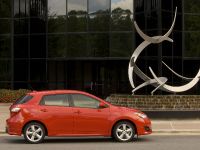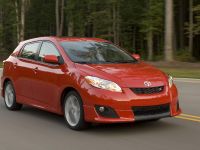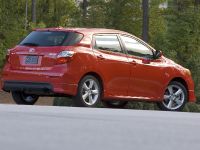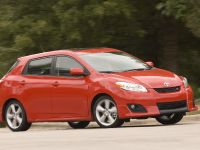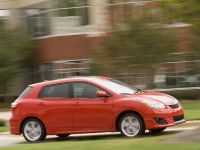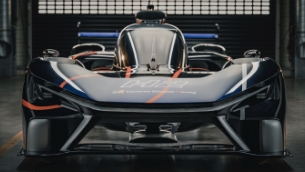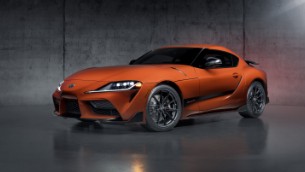All-New 2009 Toyota Matrix Completely Redesigned For Improved Performance And Utility
The Toyota Corolla Matrix, the sporty five-door vehicle that helped redefine the concept of a crossover vehicle, has been redesigned for the 2009 model year to offer better performance while maintaining fuel economy with a wider choice of functional options.
Designers created a more coupe-inspired exterior while providing enhanced interior utility and improved dynamic performance. The result is a package that has a wider, lower stance than the previous model, but maintains driver roominess and creates a more engaging to drive. The 2009 Matrix offers the choice of two different engines, 1.8- or 2.4-liters, a five-speed manual transmission, and either four- or five-speed automatic transmissions.
Matrix is available in three grades – Standard, S and the XRS. All-wheel drive (AWD) returns to the Matrix in the S grade, teamed to the new 2.4-liter engine.
Performance and Efficiency
The 2009 Matrix is offered with a choice of fuel-efficient four-cylinder engines: a new 1.8-liter and re-engineered 2.4-liter. The Matrix Standard, S and XRS are equipped with the all-new 1.8-liter DOHC four-cylinder engine, which produces 132 hp at 6,000 rpm and 128 lb-ft of torque at 4,400 rpm. Dual VVT-i (Variable Valve Timing with intelligence) controls valve timing on both the intake and exhaust camshafts to help optimize performance and economy. Internal components are optimized to reduce friction, and valve-train components are downsized to provide a compact valve layout.
A five-speed manual transmission is standard with the 1.8-liter engine, and a four-speed automatic Electronically Controlled Transmission (ECT) is available. Both automatics use a torque converter with flex lockup for increased fuel efficiency. Uphill/downhill shift control selects the proper gear for conditions and helps provide moderate engine braking during downhill driving.
The five-speed automatic can be manually shifted by moving the shift lever to the left from its "D" position into the "S" position, then pushing forward for upshifts and back for downshifts. An indicator inside the combination gauge shows the gear selected.
The Matrix XRS features the 2.4-liter four-cylinder engine. Every engine part was changed to reduce friction, increase output and ensure smooth, quiet operation. The 2.4-liter produces 158 hp at 6,000 rpm and 162 lb-ft of torque at 4,000 rpm. A balance shaft suppresses vibration, and oil jets to help piston cooling. The exhaust system is engineered for reduced backpressure for improved performance.
The 2.4-liter engine transmits its power through the five-speed manual transmission and is available with a five-speed automatic. The AWD Matrix S is equipped with the 2.4-liter four-cylinder engine and the Super ECT 4-speed automatic transmission.
Estimated-EPA fuel economy ratings are 26 MPG city/32 MPG highway for 1.8-liter manual transmission models and 25/31 MPG for the 1.8-liter automatic transmission models. Matrix models powered by the 2.4-liter engine with five-speed automatic transmission have EPA-estimated fuel economy of 21/29 MPG.
Handling and Ride
Like that of the Corolla, the 2009 Matrix chassis begins with a very stiff, rigid body structure that relies on high tensile-strength steels, gussets and crossmembers for its strength, rigidity and light weight. Front suspension is operated by a compact, rigid L-arm-type MacPherson strut with a stabilizer bar. In the 1.8-liter Matrix models, a torsion beam rear suspension with a coil-over-shock arrangement allows efficient packaging along with excellent handling and ride comfort. The 2.4-liter models get a fully independent double wishbone rear suspension system with coil-over shocks.
Four-wheel disc brakes are standard on all Matrix models. Those with the 1.8-liter engine are equipped with vented front 10.8-inch discs and 10.2-inch solid discs in the rear. Vehicles equipped with the 2.4-liter engine feature 11.7-inch vented discs in front and 11-inch solid discs in the rear (11.1-inch with AWD). The Matrix's standard 16-inch steel wheels come with sporty six-spoke full wheel covers. A distinctive 17-inch five-spoke aluminum wheel is available for the S grade, and an 18-inch aluminum alloy wheel with a twin five-spoke design is standard for the XRS.
The available AWD system is front-wheel-drive-based and distributes torque to the rear wheels through an electromagnetic coupler when needed. This active torque control system detects available traction based on signals sent from the anti-lock brake system (ABS) sensors on each wheel to the ECU.
Safety and Security
The 2009 Matrix is engineered to efficiently absorb and disperse impact energy throughout the entire body structure. Deformation of the passenger cabin is well managed due to the impact energy distribution design and high-strength steel used in the body.
All Matrix models are equipped with standard advanced frontal airbags and front seat-mounted side airbags, plus front and rear curtain side airbags. Seatbelt pretensioners retreat the seat belt at the time of a frontal collision, and the dual-stage force limiter helps limit the seat belt force applied to the passenger's chest. Front seats employ active headrests. If the vehicle is struck from the rear with sufficient force, a cable-actuated mechanism in the active headrest moves the headrest upward and forward to help limit the movement of the occupant's head.
An anti-lock brake system (ABS) with Electronic Brake-force Distribution (EBD) is standard. Vehicle Stability Control (VSC) with traction control (TRAC, including off switch) is standard on XRS and available as an option on all other models. VSC automatically adjusts engine output and the vehicle's braking force at each wheel when the system detects a loss of traction during cornering. Comfort and Convenience
The Matrix interior is designed for form, fun and functionality. Base equipment on the Standard Matrix includes 205/55 R16 tires with full wheel covers; power color-keyed outside rearview mirrors; tilt and telescopic steering wheel; daytime running lights; heavy duty rear window defogger; intermittent windshield wipers; 12-volt power outlet; four cup holders; front center console box; and an engine immobilizer.
The S grade adds standard power door locks and windows with one-touch down driver-side; 115-volt power outlet; cruise control; intermittent rear window wiper; fold-flat front passenger seat; remote keyless entry; AM/FM/CD with MP3 capability and six speakers; front and rear underbody spoilers; and fog lamps. To the S grade feature list, the XRS grade adds standard 18-inch alloy wheels with 215/45 R18 tires, a front sport strut tower brace, VSC with TRAC and off switch, and a three-spoke leather-trimmed steering wheel with audio steering wheel controls and rear spoiler deck.
The Matrix is equipped with a new, high-efficiency air-conditioning system with larger vents. The new system's compressor electronically varies output capacity based on heat load and engine speed, rather than simply cycling the compressor on and off.
Several different audio systems are available in the 2009 Matrix. The Standard Matrix comes equipped with an AM/FM/CD four-speaker system. Also available are an AM/FM/six-disc CD six-speaker system; an AM/FM/six-disc CD JBL Premium Sound system with XM® satellite, Bluetooth® and nine speakers in seven locations; and an AM/FM/CD with six-speaker system with DVD navigation with XM NavTraffic® capability. All of the audio systems include a tone-control memory feature for storing sound settings for each separate mode. Automatic Sound Levelizer (ASL) adjusts volume level in relation to vehicle speed. All systems are equipped with a universal auxiliary audio jack port that allows users to listen to their portable music players through the Matrix's speakers. Larger speakers improve sound quality for all Matrix audio systems.
Options
In addition to the array of standard equipment, an impressive list of optional comfort and utility features are available. Available options on the Standard Matrix include 16-inch alloy wheels with 205/55 R16 tires; power heated outside rearview mirror; intermittent rear window wiper; cruise control; power door locks; power windows; and remote keyless entry. The S grade also offers 215/45 R17 tires with 17-inch alloy wheels, tilt and slide power moonroof and electrochromic auto-dimming rear view mirror. An available Sport package for the S grade all-wheel-drive Matrix includes front and rear underbody spoilers and fog lamps.
Exterior Design
Toyota gave the 2009 Matrix a coupe-like exterior while maintaining interior utility and increased rigidity with reduced vibration and noise – all without any major change to the package size. The result is a sporty, dynamic shape that provides room for five people to ride in comfort.
The 2009 Matrix is 0.6 inches longer than the previous version, and about a half-inch lower in height. From the rear, the Matrix has rounded rear windows and continuous character lines that run from the front grille to the A-pillar. The S and XRS models integrate a front underbody spoiler with a large mesh fog lamp bezel and rear underbody spoiler. A rear deck spoiler is standard for all XRS models.
Interior Design
The Matrix interior is completely redesigned to enhance driving enjoyment, comfort and utility. Cabin space remains equal to that of the previous Matrix, though seating positions are lower to accommodate the vehicle's new lower profile.
The standard tilt and telescopic steering wheel enhances driving position comfort for a wide range of driver physiques. New front sport seats are equipped with standard seat-mounted side airbags. Expanded front-to-back couple distance yields more rear seat room, and the 60/40 split folding rear seat includes a center-position headrest.
Cockpit styling is anchored by a driver-oriented instrument panel and console controls. The Optitron instrument panel gauges feature bright white lighting and red needles. A large round speedometer is mounted in the center, with a tachometer to the left. A combination gauge to the right of the speedometer houses a fuel level indicator, an engine temperature indicator, and an LCD display that combines an outside temp indicator and odometer/trip meter.
A choice between two interior color schemes includes all dark charcoal or a combination of dark charcoal and ash gray. A three-spoke steering wheel adds a sporty touch. Matrix XRS models come standard with a leather-trimmed steering wheel that includes spoke-mounted audio controls and hands-free Bluetooth® capability when equipped.
A fold-down seatback table is available for the front passenger's seat on S and XRS. The front center console features a movable and removable cup support element. The cup holder area can be used as a tray when the divider is removed, and all open trays have rubber mats. Multiple storage spaces are located throughout the interior, including front and rear door pockets that each hold a 20-ounce plastic bottle. Four side panel shopping bag hooks and four D-rings in the floor provide luggage tie-down convenience. A folding tonneau cover also comes standard.

